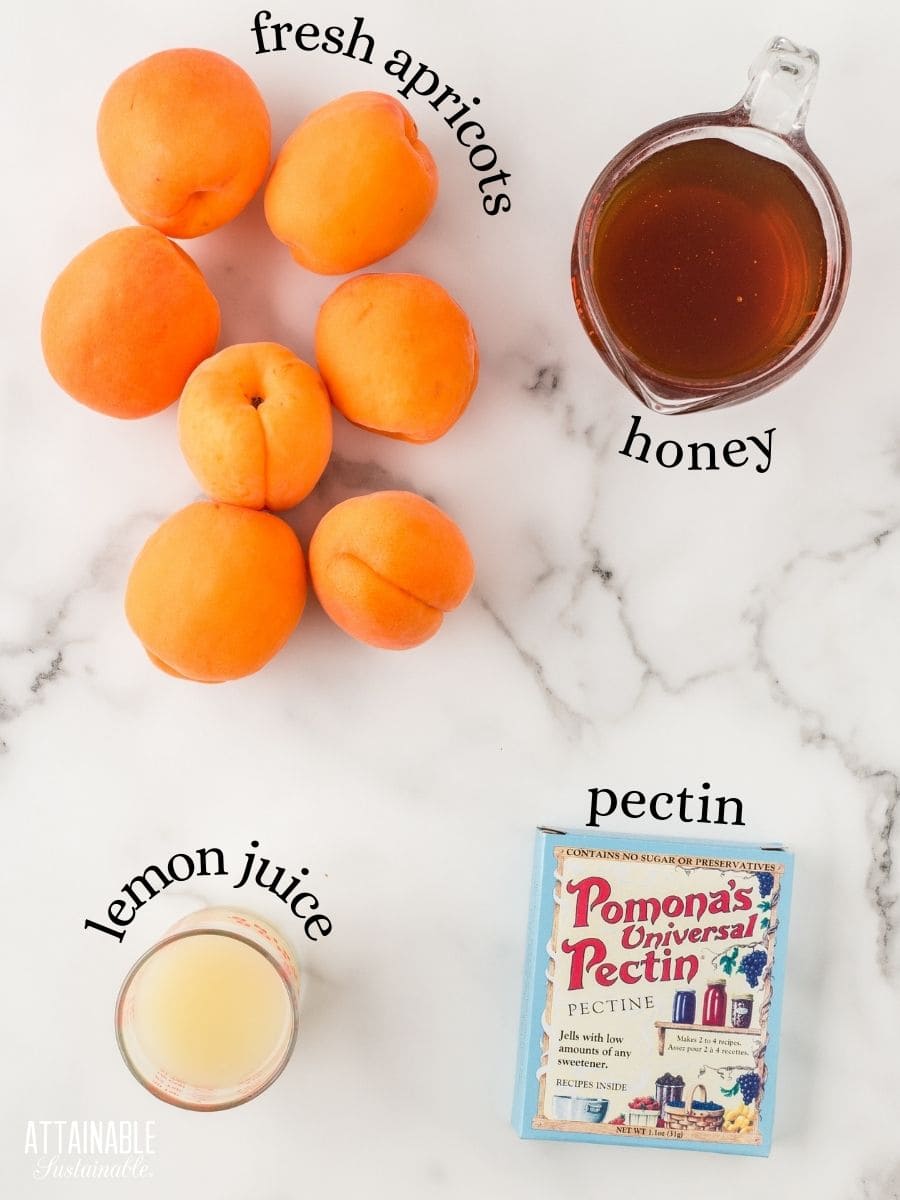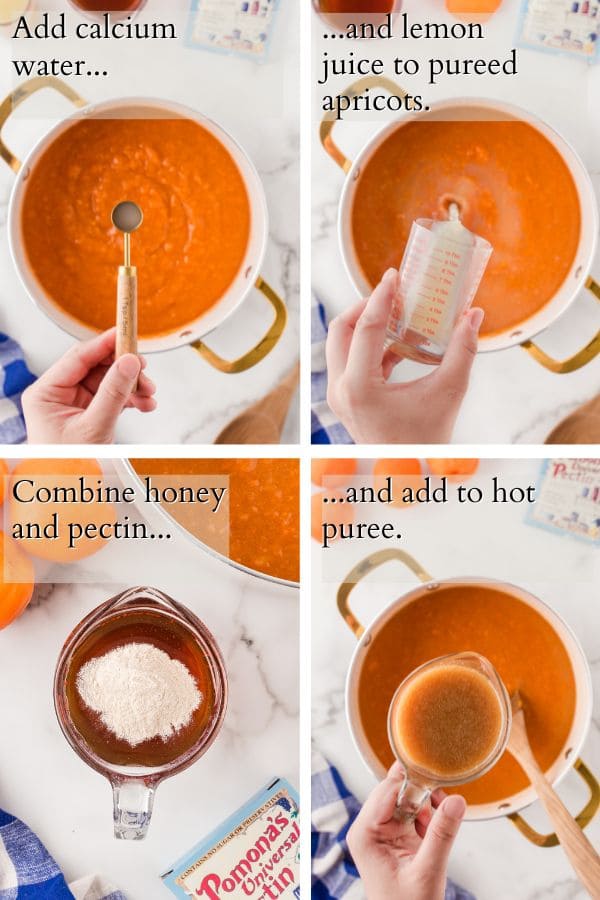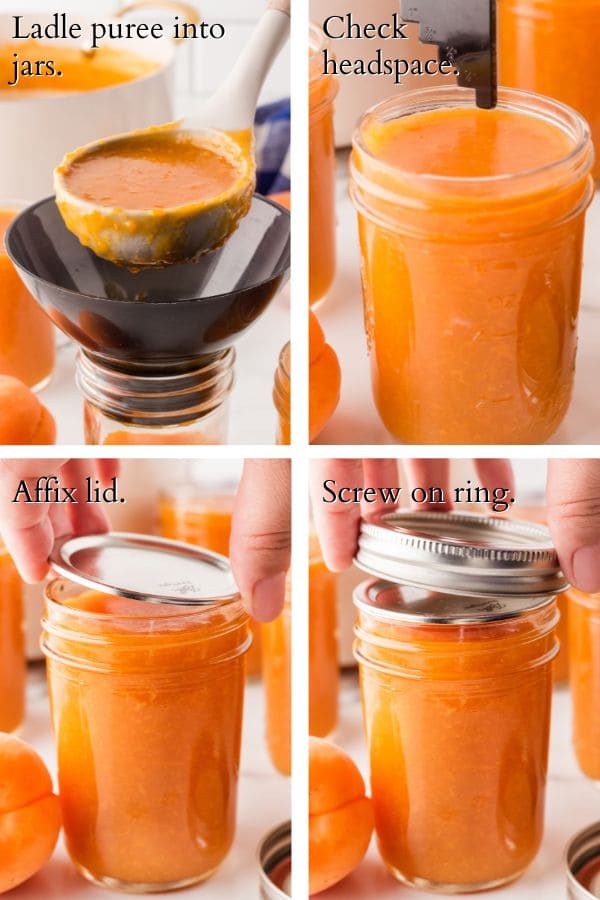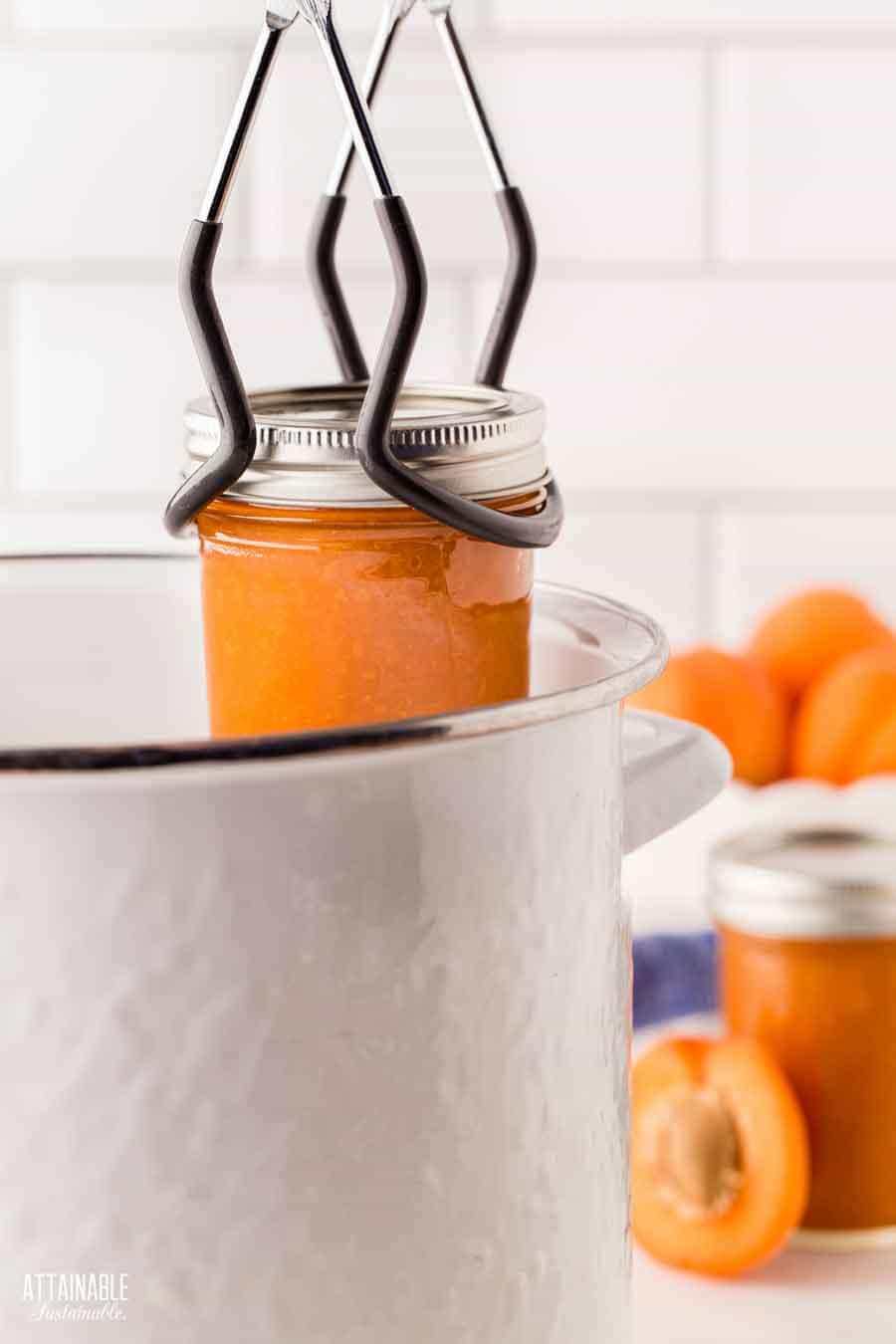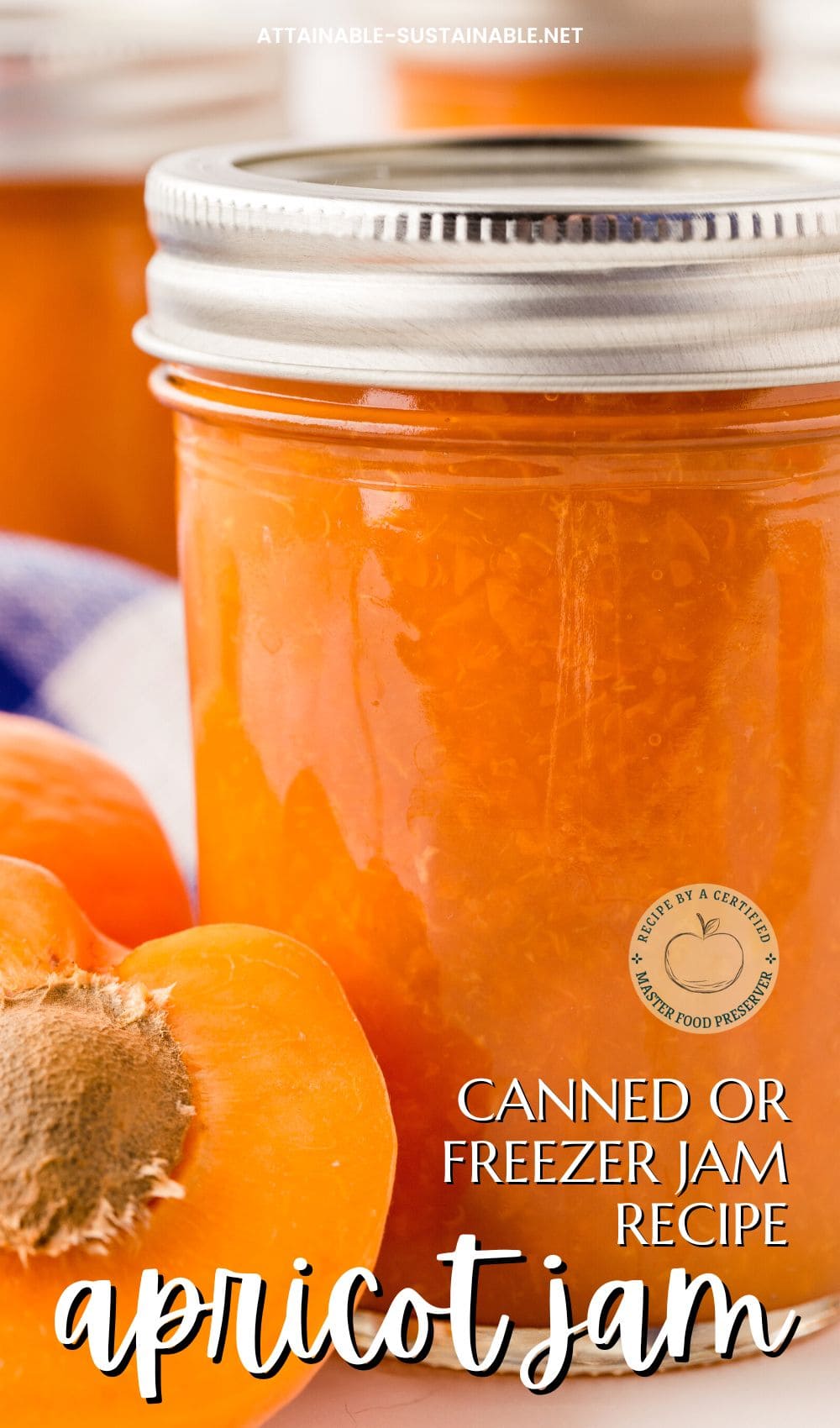Turn fresh apricots into jam for the pantry with a canning process, or preserve it as freezer jam. Either way, you’ll be able to enjoy the bright summertime flavor of these sweet stone fruits long past the harvest season.
Homemade Apricot Jam
Homemade jams are one of the easiest food preservation methods for fresh fruit and a great entry to canning. (I often suggest new canners start with jam or jelly.) If you’re not ready to delve into home canning, though? It’s perfectly fine to make this recipe and pop it into the freezer.
The Handcrafted Pantry

Ready to DIY your pantry with more wholesome ingredients? Check out my ebook, The Handcrafted Pantry! Filled with delicious recipes for some of your favorite condiments, snacks, and toppings, it’s the guide you need to start skipping packaged products and embrace homemade.
Ingredients
Apricots — The key ingredient here, choose fruit that is fully ripe for the best flavor. Avoid overripe fruit. Freestone varieties of apricots (and all stone fruit) are easier to work with than clingstone varieties. Happily, most apricots available to consumers are freestone, and the pit slips easily from the flesh.
Sweetener – I used honey for this recipe, but you can opt to use sugar as well. The quantities differ a bit, so be sure to check the notes in the recipe card below for using refined sugar.
Lemon juice – Use bottled lemon juice to assure that the resulting pH for this recipe falls within safe canning guidelines.
5 Easy Steps to Transform Your Pantry!
Ready to switch from store bought to homemade? Let me help you make some changes! Grab my FREE five-part guide to getting started.
Pectin – This recipe is made using Pomona’s Universal Pectin. This is the only pectin I use anymore as it allows me to use much less sugar (or other sweetener). The standard pectin brands use too much sugar in my opinion, often requiring equal amounts of sugar and fruit! This product uses a low methoxyl method and calls for using two different ingredients, which are included in the box: pectin (the large packet) and calcium powder (the small packet). The dry pectin is mixed with the sweetener before being added to the fruit. The calcium water is added directly to the fruit. This low sugar pectin works a little differently, but makes a delicious, fruit-forward jam.
Making the Jam
Wash and dry the apricots. Halve and remove pits, then puree the fruit by pulsing in a food processor.
Peeling the fruit is optional; if you’d prefer to remove the fuzzy skins, use this method.
If you don’t have a food processor, start by heating the apricots in a stock pot with about a half cup of water until softened. Once soft, use a potato masher or run the cooked fruit through a food mill to create a puree.
Measure eight cups of the pureed/mashed apricots into a large stockpot along with the calcium water and lemon juice.
Combine the pectin with the honey, making sure it’s thoroughly combined.
When the apricot mixture reaches a full rolling boil, add the honey to the cooking fruit, stirring for a minute or two to assure that the pectin is well distributed.
Apricot Freezer Jam
Once the jam is made, transfer it to freezer safe containers while it’s still hot. I like to use straight-sided canning jars, but your favorite freezer containers will work just fine. You do not need special containers – upcycled jars work great, too.
Leave a headspace of at least an inch to allow for expansion when the jam freezes.
Let the jam to cool completely, then affix lids and transfer to the freezer. Store for up to a year in the freezer.
To use the apricot freezer jam, transfer the container from the freezer to the refrigerator and allow to thaw completely.
Canning Process
This recipe measured at a pH under 3.5, putting it well into the “safe” zone for water bath canning.
You’ll need special canning jars, lids, and rings to make this a shelf-stable product, but the process isn’t difficult.
Transfer hot preserves into canning jars, leaving a quarter-inch headspace. Use a non-metallic knife or bubble tool to remove any air bubbles. Wipe the rims of the jars, removing any residue.
Place the lids on and process them in a water bath canner. What this means is you’ll put the filled and sealed jars of jam into boiling water and heat them for a specific amount of time. This assures that the jars will seal well and kills off any potential bacteria in the jam mixture itself.
Jars must be covered by 1″ to 2″ of water.
Use a jar lifter to remove the hot jars to a towel-covered countertop and allow to cool fully. As they cool, you’ll hear the little “tink” sound of the jars sealing. Store any unsealed jars in the fridge and use those first. (This is unusual, but it does happen once in awhile.)
Remove the ring from each sealed jar of apricot preserves, rinse to remove any sticky residue, and store (without the ring) at room temperature in a dark place such as the pantry. Opened jars should be kept refrigerated; they’ll last in the fridge for several weeks.
🍅 Safety First!
Canning is an excellent way to preserve food for the pantry, but there are some important safety considerations to keep in mind. The recipes on this site have been made following safe canning procedures by a certified Master Food Preserver.
- Know the difference between water bath canning and pressure canning. Low acid items must be pressure canned for safety.
- Altering ingredients may change the recipe’s pH, posing a safety issue. I highly recommend investing in pH paper to test your products for acidity level when canning. Note: For safe water bath canning, the Hawaii Master Food Preservers suggest a pH of 4.2 or lower in the tropics. In other regions, the recommended pH is 4.6 or lower.
- Use the proper jars and lids. Never reuse lids, with the exception of the Tattler or Harvest Right hard plastic lids that are intended for such a purpose.
- For more on canning equipment, please go here.
- Want to learn more? The National Center for Home Food Preservation is the go-to resource for safe canning information.
Using this Jam
Spread it on toast (of course!) or serve this apricot jam recipe with vanilla ice cream, use it in thumbprint cookies, or stir some into yogurt. It’s also great to use as a glaze for grilled chicken and fish.
Storage
Opened jars of jam should be stored in the refrigerator. Once opened (or thawed), the jam will last for up to a month in the refrigerator.
★ Did you love this recipe? Be sure to give it a star rating below! ★
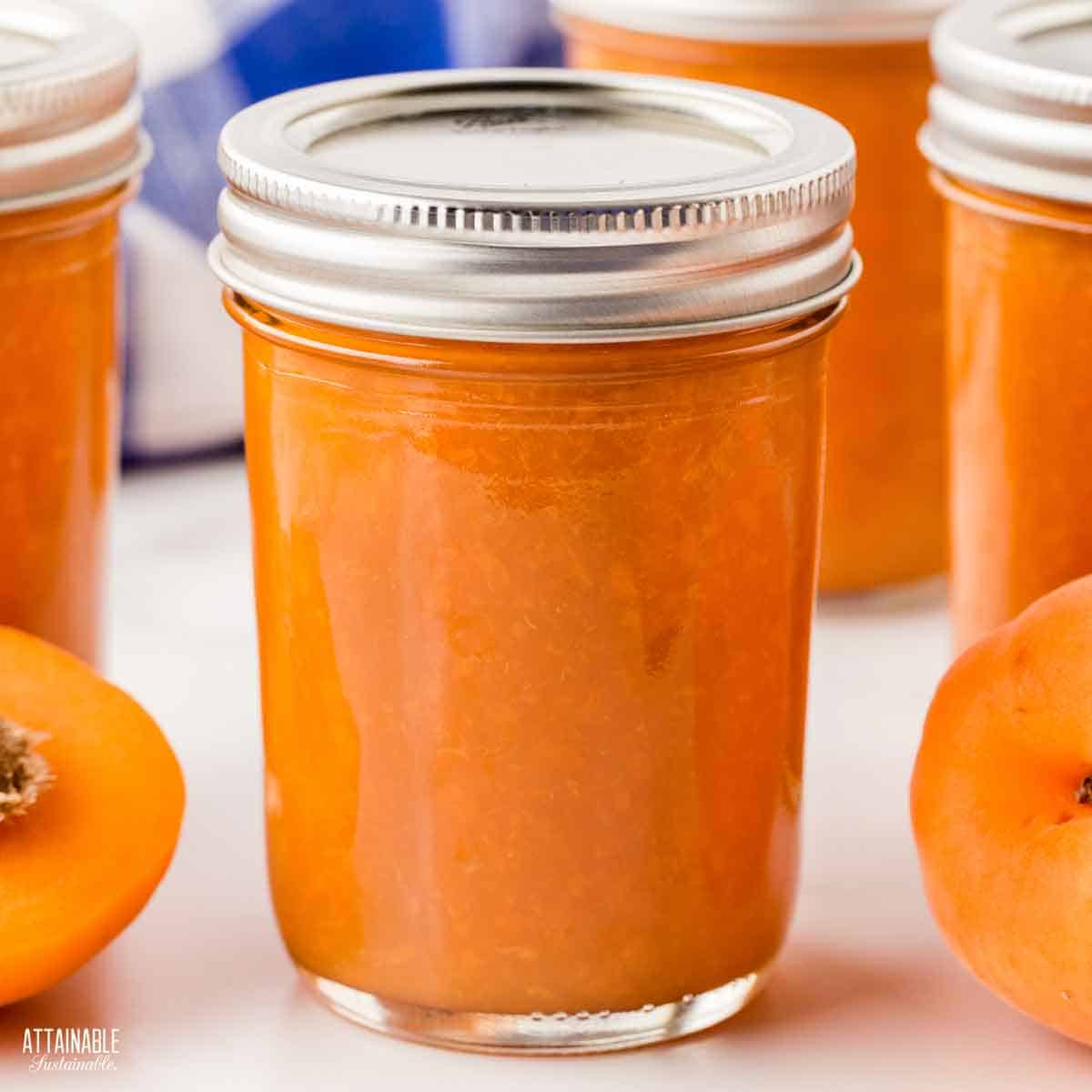
Homemade Apricot Jam
Ingredients
- 8 cups apricots mashed (6-7 pounds)
- 8 teaspoons calcium water from Pomona's Universal Pectin
- ½ cup lime juice bottled
- 1 cup honey
- 2 tablespoons pectin powder from Pomona's Universal Pectin
Instructions
Prep ahead:
- Prepare calcium water from Pomona pectin. Put 1/2 tsp calcium powder (the small package) and 1/2 cup water in a small jar with a lid. Shake well before using.
- Fill a canning pot with water, set the lid in place, and heat on high heat to a simmer while you're cooking the jam.
Make the jam
- Halve the apricots and remove pit; pulse apricots in a food processor. The skins should be chopped well. Measure 8 cups of apricot pulp into a large pot. Add the prepared calcium water and lime juice; stir to combine well.8 cups apricots, 1/2 cup lime juice, 8 teaspoons calcium water
- In a separate bowl, combine the honey with the pectin powder (the large envelope) until thoroughly combined.1 cup honey, 2 tablespoons pectin powder
- Bring mashed apricots to a full boil. Add honey mixture, stirring vigorously for a couple of minutes to dissolve the pectin. Return to a full boil, boil for one minute, and remove from heat.
Apricot freezer jam
- Transfer hot jam to freezer safe containers. Leave a headspace of at least an inch to allow for expansion when the jam freezes.
- Let the jam to cool completely, then affix lids and transfer to the freezer. Store for up to a year in the freezer.
Canning apricot jam
- Ladle hot jam into half-pint jars to within a quarter inch of the rim. A canning funnel makes this easy.
- As jars are filled, wipe the rim of the jar to remove any jam that may have spilled. A clean rim is essential to a good seal.
- Place lids on the jar. Screw bands on finger tight.
- Use a jar lifter to gently place jars into the boiling water canner. Be sure to place a wire rack in the bottom of the pot to prevent the jars of jam from sitting directly on the bottom. Water should cover the top of the jars by an inch or two. The water will cool somewhat in reaction to the addition of the jars. Return the water to a low boil and then set the timer.
- Process in a boiling water bath for 10 minutes. Add a minute to the boiling time for every 1,000' above sea level.
- Check seals. Lids should be solid and pulled down tight. (iIf they flex and pop, the jar didn’t seal; put unsealed jars in the refrigerator and use those first).
- Remove rings and wash the outsides of the jars. Store in a cool, dry place.
Notes
- This recipe is made using Pomona’s Universal Pectin. This is the only pectin I use anymore as it allows me to use much less sweetener. The standard pectin brands use an obscene amount of sugar in my opinion, often requiring equal amounts of sugar and fruit! This product uses a low methoxyl method and calls for using two different ingredients, which are included in the box: pectin (the large packet) and calcium powder (the small packet).
- If you'd prefer to use sugar, use 1.5 cups granulated sugar to replace the 1 cup of honey.
- This recipe can be made using half-pint jars if you prefer.
- This recipe tests below 3.5 pH.
- Boiling lids or heating above 180°F as once recommended can damage the sealing compound.
Nutrition

